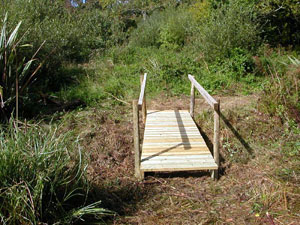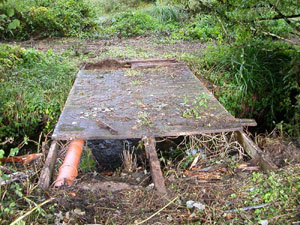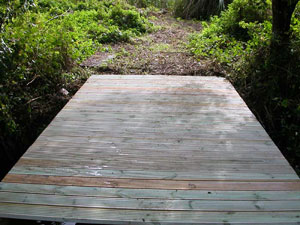Building bridges.

If you are lucky enough to have a brook, stream or river flowing through your woodland, you will almost certainly want to cross it. Where the water-course is narrow, the banks are low and the water is normally less than welly-deep, then you might be happy to just hop or wade across, particularly if the crossing point is in some out of the way spot. But if the crossing point is on a well used path then a bridge may be needed. Or maybe you already have rickety old structures which need replacing – as was the case with the examples shown, which are at one of the locations I manage for woodlands.co.uk in Cornwall.
 The structures described are primarily for pedestrian use only. If you want to drive across, then something more substantial will be required.
The structures described are primarily for pedestrian use only. If you want to drive across, then something more substantial will be required.
These simple bridges are made up of two, maybe three components:
Bearers: these are the bits which support the structure and span the width of the stream, from bank to bank. Sawn tanalised timber is best. For spans of up to about 12 feet, 6” x 2” timber is adequate. For wider spans, at least 9” x 3” is recommended. For footbridges up to about 3 feet wide, then one bearer at either side is sufficient. For wider bridges, a central bearer will also be required to prevent the boards from sagging in the middle.
Boards: sawn timber could be used, decking boards are better (uniform dimensions, sturdy, rot-resistant and not as slippery when wet).
 Handrails: an optional item. On narrow footbridges, especially if there is much of a drop either side, then a handrail can be a reassurance. On wider bridges where there is no need to walk close to the edge, then they are not really necessary. Ordinary 2”-3” fencing stakes for the uprights and planed, treated 3” x 2” timber for the rails will do the job.
Handrails: an optional item. On narrow footbridges, especially if there is much of a drop either side, then a handrail can be a reassurance. On wider bridges where there is no need to walk close to the edge, then they are not really necessary. Ordinary 2”-3” fencing stakes for the uprights and planed, treated 3” x 2” timber for the rails will do the job.
Construction:
- take your time to get the bearers level and parallel. Get this part right and the rest of the task is very straightforward. Temporarily attaching a board at each end, between the bearers ensures that the bearers are parallel (assuming the boards have been cut to the same length)

- the bearers are set on their shorter side eg if using 6” x 2”, on the 2” side. Setting the bearers on concrete blocks, bricks or similar ensures that they do not sink into the ground and keeps the whole structure level.
- If using handrails, drive the uprights in about 6” – 12” from each end of the bearers so that they are touching the outside of the bearers. Screwing or bolting through the posts and into the bearers will help make the structure more rigid
- working from one end of the bridge, attach the boards with 2 screws in each side (and two in the middle if a central bearer has been used)
- gaps between the boards aid with water run-off and save on timber – but are a matter of personal preference. Gaps should be at least ½” wide, up to about the thickness of the decking boards
- when you reach the other side, you may need to reposition the board which was temporarily attached – but only if you are concerned about having consistent gap widths.
- attach the handrails to the inside of the uprights (screwing/bolting from in to out) and give the edges a quick sand down to avoid splinters
And that’s it, job done. Now you can cross your water-course in safety and comfort.
Comments are closed for this post.
Discussion
any great ideas for a bridge that could hold a landrover carrying logs? A friend we know could do with one!
Tracy
This post brings to mind a book sat on my shelf that I consider to be my bible as far as bridge construction is concerned:
Footbridges in the Countryside. Design & Construction
Commissioned by the Countryside Comission for Scotland about 30 years ago
I put this title into Google & first up came the following:
http://www.ittransport.co.uk/documents/Manual%20-%20Final%20Version% 20June%2004%20Low%20Res.pdf
Scrolling through this file there seems to be most of what I’ve got & a few additions, including bamboo bridge construction up to a 12m span !
It’s all practical stuff with the benefit of an engineer having done the sums.
Additionally:
http://handbooks.btcv.org.uk/handbooks/content/section/2346
might be of interest.

Depending on access, scrapped truck or trailer beds from transport companies provide a ready built possibility.
Simon Fraser
8 November, 2010